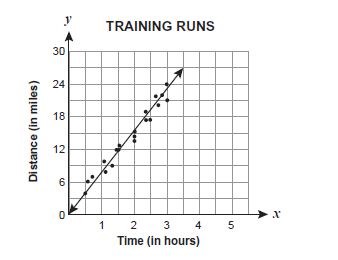Remarks
Example 1: As your family is traveling along an interstate, record the odometer reading every 5 minutes. See if a graph of time and distance shows that the relation is approximately linear. If so, write the equation of the line that best fits your data. Predict the time for a journey of 50 miles. What does the slope of the line represent?

Example 2: You light a candle and record its height in centimeters every minute. The results recorded as (time, height) are (0, 20), (1, 18), (2, 16), (3, 14), (4, 13), (5, 11), (6, 10), (7, 8), (9, 4), and (10, 3). Find the line of best fit to express the candle's height as a function of the time and state the meaning of the slope in terms of the burning candle.
-
Item Type(s):
This benchmark may be assessed using:
MC
,
FR
item(s)
Also Assesses: - Clarification :
Students will use linear equations to make predictions and/or find and use the rate of change (slope). - Content Limits :
Graphs may be located in any of the quadrants.
Items may include linear equations in various forms, including standard, point-intercept, and point-slope forms.
In items assessing slope as a rate of change, the slope should be presented as a ratio.
- Stimulus Attributes :
Items may be set in either real-world or mathematical contexts.
Graphics should be used in most of these items, as appropriate.
- Response Attributes :
Fill-in response items may require that students provide a slope, the x-coordinate of the x-intercept, the y-coordinate of the y-intercept, or the x-coordinate or y-coordinate of a point of interest.
Fill-in response items may have a negative answer.
MA.912.A.3.12 Graph a linear equation or inequality in two variables with and without graphing technology. Write an equation or inequality represented by a given graph.
- Test Item #: Sample Item 1
- Question:
David is training for a marathon. He writes down the time and distance for each training run and then records the data on a scatter plot. He has drawn a line of best fit on the scatter plot, as shown below.

Which statement best expresses the meaning of the slope as a rate of change for this line of best fit?
- Difficulty: N/A
- Type: MC: Multiple Choice
- Test Item #: Sample Item 2
- Question:
Joel graphed the line shown on the coordinate plane below.

What is the x-coordinate of the point at which this line intersects the x-axis?
- Difficulty: N/A
- Type: FR: Fill-in Response
Related Access Points
Related Resources
Lesson Plan
Problem-Solving Tasks
Unit/Lesson Sequence
Video/Audio/Animations
Student Resources
Video/Audio/Animation
Khan Academy tutorial video that demonstrates with real-world data the use of Excel spreadsheet to fit a line to data and make predictions using that line.
Type: Video/Audio/Animation
Parent Resources
Video/Audio/Animation
Khan Academy tutorial video that demonstrates with real-world data the use of Excel spreadsheet to fit a line to data and make predictions using that line.
Type: Video/Audio/Animation








